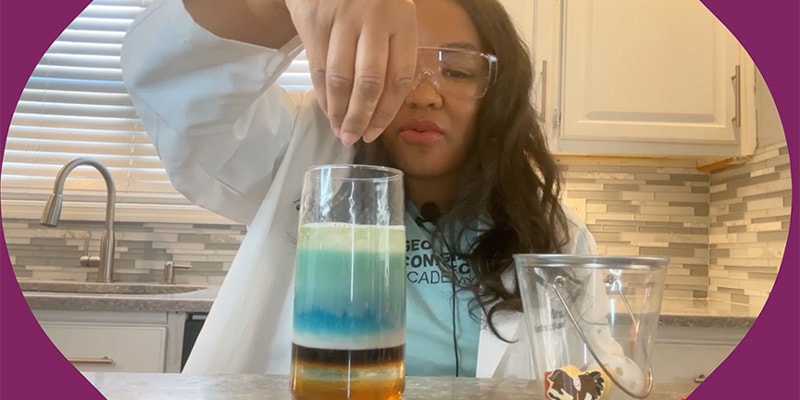The Power of STEM in Early Elementary Education: A Hands-On Density Experiment
byKevin Neese
5 min to read
STEM (Science, Technology, Engineering, and Mathematics) education plays a transformative role in a child's development, cultivating essential skills that can benefit children throughout their lives. By engaging elementary-aged students in activities that spark their curiosity, we open doors to explore the world around them in a meaningful way.
Why STEM Matters in Early Elementary Education
Children are natural investigators, brimming with questions and an eagerness to experiment. STEM activities harness this innate curiosity and provide a framework for discovery. Let's delve into the specific benefits of early STEM exposure:
Strong Foundations for Future STEM Success: Early STEM learning lays the groundwork for more complex concepts in STEM. Children who tinker with basic scientific principles and mathematical relationships are more likely to become comfortable with these fields, increasing the likelihood of pursuing STEM on their own in the future.
Critical Thinking and Problem-Solving: Problem-solving lies at the heart of STEM. Through activities and experiments, children learn to break down challenges, analyze information, and develop creative solutions.
Fostering a Love of Learning: Hands-on STEM experiences can make learning into an adventure. When children engage in STEM activities, they can discover the joy of asking questions, making predictions, and seeing the results of their experiments unfold.
Adaptability and Resilience: STEM often involves trial and error. By encountering obstacles and learning to overcome them, children build resilience and the confidence to tackle new challenges.
Putting STEM into Practice: The Density Experiment
The scientific method is a cornerstone of STEM learning. It provides children with a structured way to explore the world around them. Let's put this method into action with a fun and engaging density experiment!
What is Density
Density describes how much stuff is packed into a space. Think of a fluffy cotton ball and a heavy rock. They might be the same size, but the rock feels much heavier. This is because the rock's matter is packed more tightly, making it denser.
Exploring Density with a Layered Tower
In this experiment, we're going to build a colorful tower of liquids in a clear drinking glass to see how density works. Different liquids have different densities, meaning some are heavier than others. By carefully layering liquids, we'll see how density causes them to stack in a surprising way.
Materials Needed
For this experiment, you’ll need the following items:
Safety glasses
One tall, clear drinking glass (or clear container)
Two glasses (for mixing other liquids separately from the main container)
Honey
Corn syrup
Maple syrup
Dish soap
Water
Vegetable oil
Rubbing alcohol
Whole milk
Small objects of varying densities (such as a coin, ping pong ball, dice)
Food coloring (two different colors)
Optional: Dropper
Steps
Honey Time! Put on your safety glasses and carefully pour some honey into the bottom of your glass.
Syrupy Surprise! Next, slowly add a layer of corn syrup. What do you notice?
More Syrup! Gently add some maple syrup. Cool, the layers are stacking!
Milky Mix: Time for the whole milk. Why do you think we use whole milk instead of low-fat milk? (Hint: think about density!)
Soapy Splash: Add a layer of dish soap.
Water Wow! Pour some water into a separate container. Add a few drops of food coloring and mix. Now carefully pour the colored water into your main glass.
Oily Top: Time for the vegetable oil!
Colorful Alcohol: Pour rubbing alcohol into another separate container and add a different food coloring. Mix it up, then slowly add it to the top of your glass.
Floating Fun! Now it's time to test! Drop in your objects one by one. Will they sink or float? Before you drop them, guess which layer they might stop in!
The Science Behind It
Materials have different densities. Heavier materials sink to the bottom, while lighter materials float. This explains why your objects end up in different places within the layered tower.
Beyond the Experiment: Expanding STEM at Home
Embrace Everyday STEM: Look for science in daily life. Inspire kids even further with these tips on how to spark curiosity in STEM online school environments.
Explore Virtual Labs: Online simulations and games offer interactive STEM activities.
Encourage Questions and Investigations: Welcome your child's "why" and "how" questions with enthusiasm.
Ignite Your Child's Passion for STEM
Early STEM education isn't just about creating future scientists and engineers; it's about igniting a lifelong passion for learning and discovery. By providing children with opportunities to explore, experiment, and ask questions, we set them up for success in all areas of their lives.
At Connections Academy, we believe in the power of STEM education from a young age. Our curriculum incorporates hands-on activities and engaging projects that make STEM concepts come alive. If you're ready to empower your child with the skills for a bright future, learn more about Connections Academy's approach to STEM learning.



